![[ACLU Execution Watch
Counter]](http://www.aclu.org/graphics/dpcounter.gif)
The Lindbergh Kidnapping Hoax
RECENTLY DISCOVERED! RANSOM NOTE EVIDENCE
![[ACLU Execution Watch
Counter]](http://www.aclu.org/graphics/dpcounter.gif)
![]() Clarification of Table
Evidence by Mark Falzini
Clarification of Table
Evidence by Mark Falzini
![]() Forensic
Evidence Removed By American Lindbergh Family
Forensic
Evidence Removed By American Lindbergh Family
![]() Meet
the German Lindbergh Family too!
Meet
the German Lindbergh Family too!
![]() NY
Times Article June 22, 2003
NY
Times Article June 22, 2003
![]() Lindbergh
Kidnapping Hoax Forum
Lindbergh
Kidnapping Hoax Forum
![]() Ronelle Delmont's
Lindbergh Kidnapping Hoax
You Tube Channel
Ronelle Delmont's
Lindbergh Kidnapping Hoax
You Tube Channel
June 22, 2003 The New York Times Reports On New Evidence
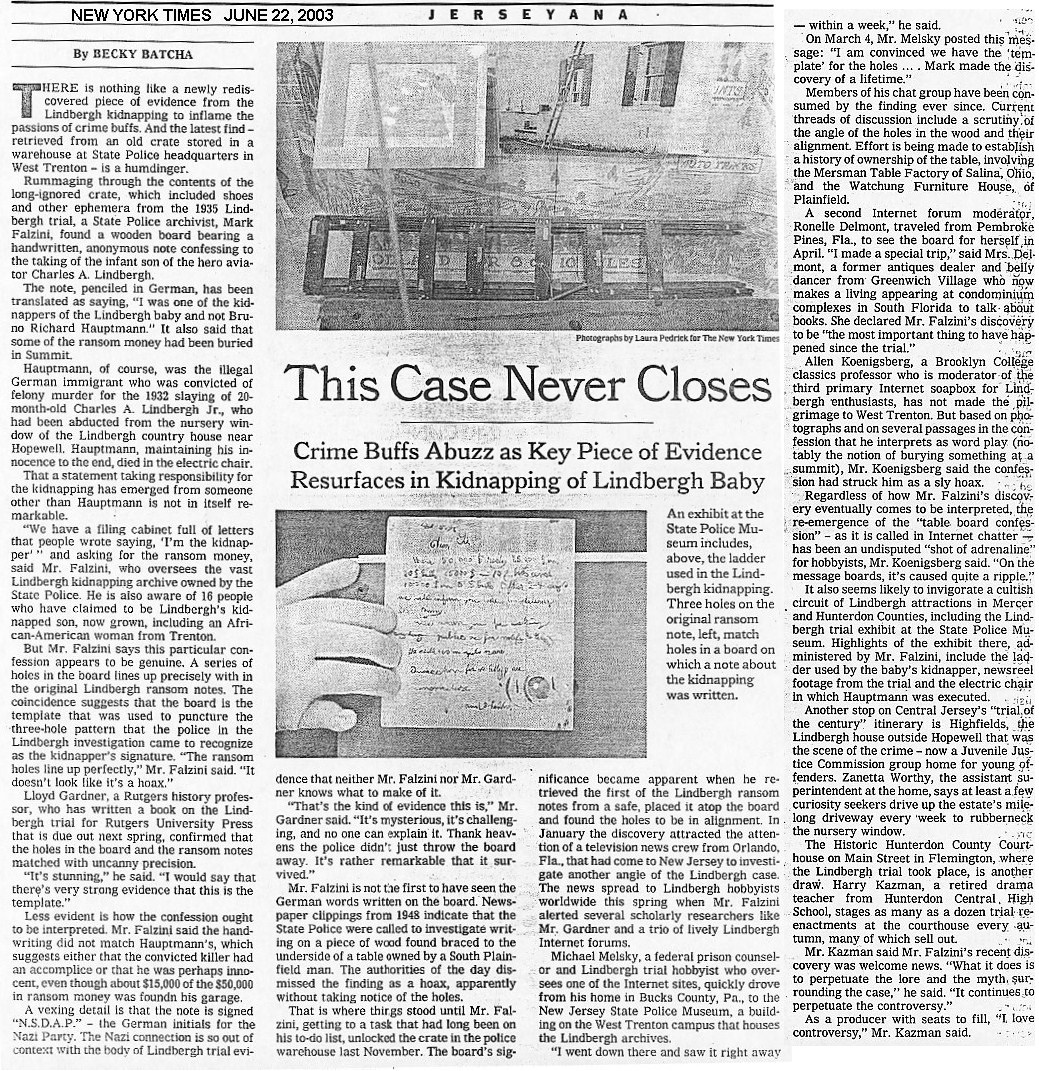
![]()
![]()
![]()
Mysterious Confession on the Mersman Table Brace
In
Hamburg da bin ich gewesen in Samet und in Seide gekleidet
In Hamburg I used to be dressed in velvet and silk
Meinen Namen den darf ich nicht nennen
I am not allowed to say my name
Denn
then
Ich war einer der Kidnapper des Lindberg [sic] babys [sic]
I was one of the kidnappers of the lindbergh baby
und nicht Bruno Richard Hauptmann
and not Bruno Richard Hauptmann
Der Rest des Lösesgeldes liegt in Summit New Jersey begraben
The rest of the ransom money lies buried in Summit NJ
N.S.D.A.P.
National Socialist Worker's Party [NAZI party]
The German Song (Lied) Quoted in The Mersman Brace Confession
In Hamburg,
da bin ich gewesen,
In Samt und in Seide gehüllt,
Meinen Namen den darf ich nicht nennen,
Denn ich bin ja ein Mädchen fürs Geld.
Mein Bruder, der hat mir geschrieben:
Ach Schwester, ach, kehr doch zurück!
Deine Mutter liegt schwerkrank darnieder;
Sie beweinet ihr einziges Glück.
Da hab ich ihm wieder geschrieben:
Ach Bruder, ich kann nicht zurück,
Meine Ehr' ist in Hamburg
gebleiben,
In der Heimat, da find ich kein Glück.
Ach Mutter,
ich bin ja verloren,
Verstoß nicht dein unglücklich Kind.
Du hast mich in Liebe geboren,
Für das Gute da ward ich zu blind.
In Hamburg,
da bin ich gewesen,
In Samt und in Seide gehüllt,
Meinen Namen den darf ich nicht nennen,
Denn ich bin ja ein Mädchen
fürs Geld.
Photos below were taken in April 2003 by Ronelle Delmont at the W Trenton Archive. Thanks to Mark Falzini for all the help in presenting this information. The middle photo was taken by NJ Police in 1948 - they did not save a single report on this discovery and brushed it off as a complete hoax. The only thing they saved were 2 photos and the wooden brace itself.
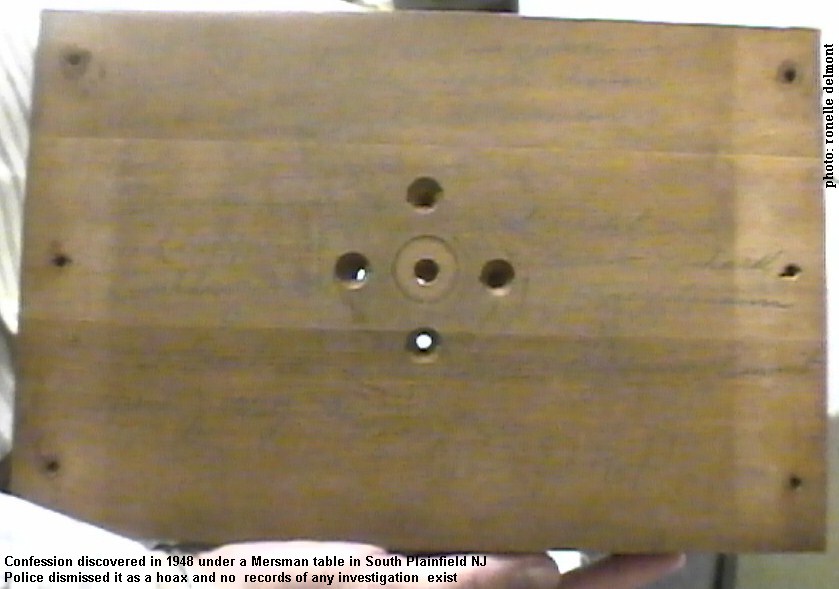
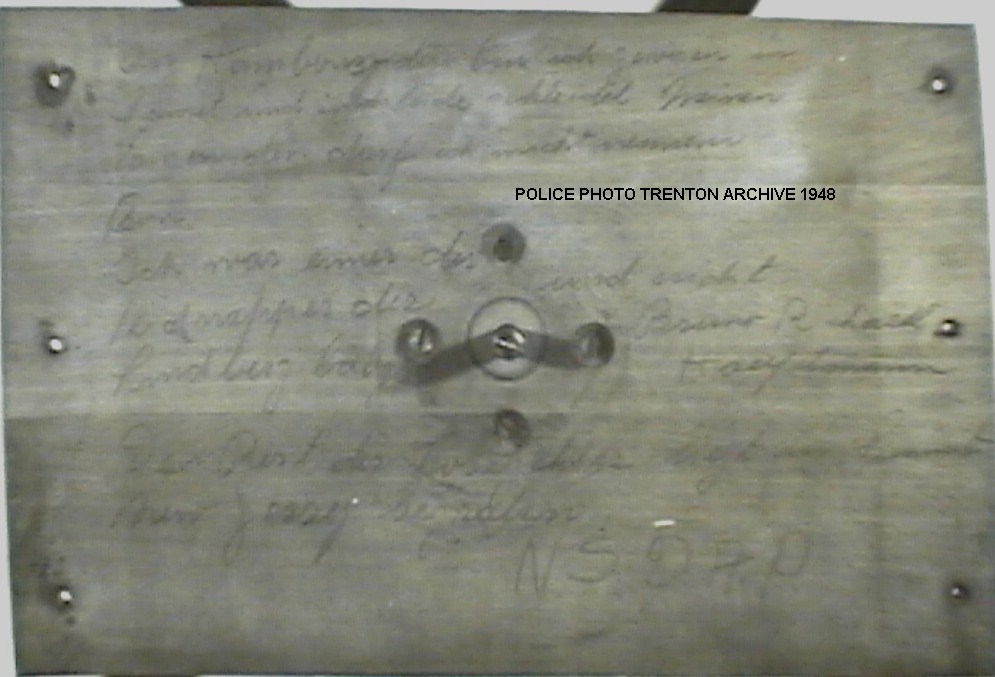
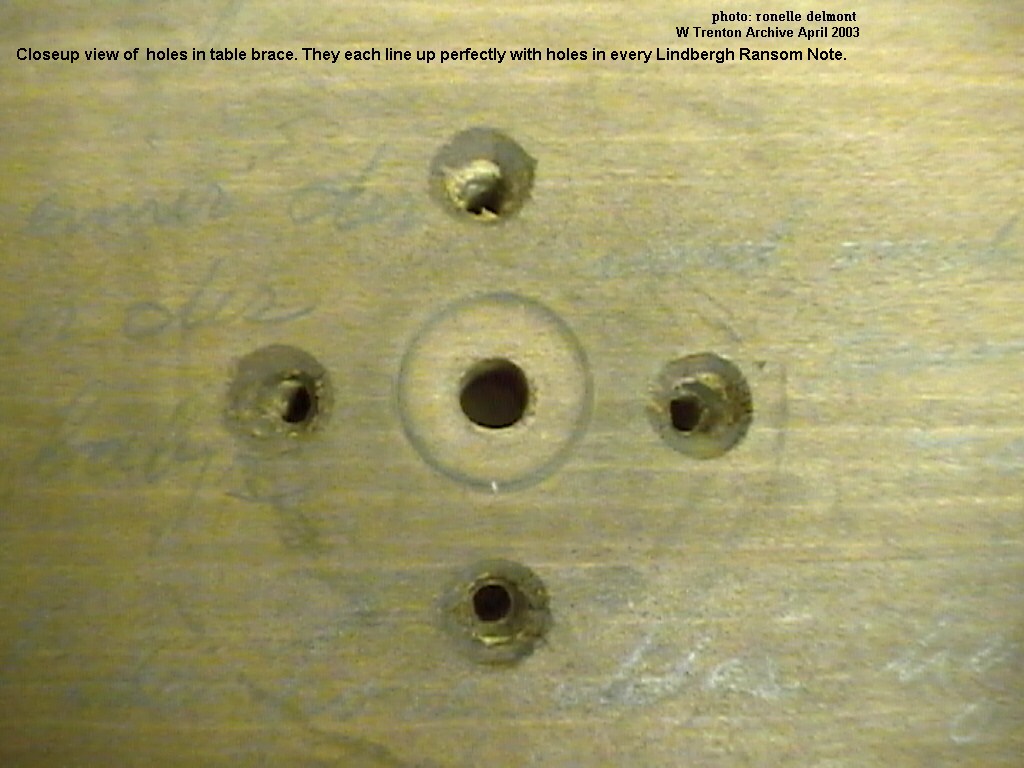
Forensic Items Removed From the West Trenton Archive -
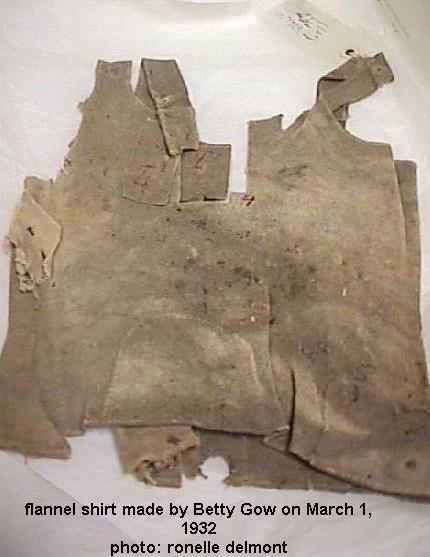 And,
The Hesshaimer Lindberghs
And,
The Hesshaimer Lindberghs
Regarding the latest sensational news from German publications about Lindbergh's secret German family , Scott Berg is still the Lindbergh family-authorized mouthpiece. No one has yet asked him why the Lindberghs recently took the bones of their deceased brother out of the NJ Police Museum.
It
is amazing that not a single journalist seems to be aware of the fact that the
American Lindberghs, a few months ago, very suddenly removed every scintilla of
potential DNA evidence from the NJ State Police Museum in West Trenton New
Jersey. Even New York Times reporter, Becky Batcha, who wrote an excellent piece
for their NJ edition on June 22, failed to understand the meaning of this
action, though, she must have seen the empty spaces in the Trenton Museum
showcase at the time of her visit there.
The swift removal of forensic artifacts occurred on May 8, 2003 and those of us
who research and write about the Lindbergh kidnapping were shocked to learn
about it. On my message
board the topic at that time had been the ill-health of Charles Lindbergh Jr
(he had rickets) and what genetic bone disease he might have suffered from.
Obviously, we all thought the removal of those bone fragments from the museum
had something to do with our online discussions. Something was about to happen
but we didn't know what it was until the German Lindberghs revealed themselves
last week.
Here is the email I received 2 months ago from Mark Falzini, the
Curator/Archivist of the W Trenton State Police Museum which houses all of the
Hauptmann trial evidence.
"By order of the Attorney General's Office, the sleeping suit, thumb guard,
and B. Altman t-shirt as well as the contents of the jars that were on display,
and the hair and bone fragments were all returned to the Lindbergh family
earlier this month.
The signed statement from the Lindberghs reads:
"The Lindbergh Family has honored the longtime wish of Anne Morrow
Lindbergh that the remains and personal effects of Charles Lindbergh, Jr. be
returned to the family for appropriate disposition. Today, Charles, Jr.'s
siblings express their appreciation to the New Jersey Attorney General's Office
and the New Jersey State Police Museum for returning these items and for
enabling Mrs. Lindbergh's wishes to be fulfilled.
(sg) Land M. Lindbergh
(sg) Reeve Lindbergh
May 8, 2003"
The American Lindberghs have repeatedly refused to give samples of their DNA
over the years and now they have secretly forced NJ to hand over all the
forensic items pertaining to their dead brother. Tiny fragments of soil, bone
and hair as well as the clothing.
Their desperate actions, in collusion with the Attorney General of New Jersey,
may also be illegal as Governor Brendan Byrne, in the 1980s, designated the
entire collection as "historical" artifacts. Their brother had been
cremated by their father (he was in charge of the entire investigation)
immediately after his body was discovered and no forensic autopsy was ever
conducted.
Suspicions about the identity of that corpse have remained to this day and the
only hope for an answer to that question was, of course, in DNA testing. Since
the State of NJ most probably executed an innocent man for that crime NJ
authorities have repeatedly refused to allow any forensic tests on any of the
items in the archive - including the ladder, attic floorboard, ransom note
envelopes, etc.
Yet, they turned over ALL of the potentially informative items to the family of
the victim 70 years later when it had already been designated as a historical
collection by the Governor in an Executive Order.
There is much reason to be outraged by all of this in spite of the sympathy that
might be inspired by the thought of a family receiving the last remains of their
long dead brother.
Last November investigative reporter, Mike
Holfeld of WKMG in Orlando attempted to get permission for saliva DNA tests
of certain envelope flaps housed in that Museum - especially the nursery ransom
note envelope. Everything had been agreed upon for DNA tests to be paid for by
WKMG and at the last minute WKMG was told by the Attorney General that they
would not allow it. The AG stated, in a letter to Mike Holfeld, that the archive
is designated as "historical" and, therefore, cannot be touched.
Yet, a few months later, unbeknownst to the public, the AG surreptitiously
handed over ALL that remained of the evidence relating to the body and identity
of Charles Lindbergh Jr. Even Mark Falzini knew nothing of this until they
ordered him, within 24 hours, to pack it all up. (Luckily, he was able to find a
Police photographer to preserve what he could on film.)
I understand the sympathy people will have for the American Lindberghs and their
attempt to quietly sneak the DNA out of the NJ museum in case their European
siblings try to use those fragments of bone, teeth and hair to prove their
heritage. But, if New Jersey's Attorney General can allow those items out of
public scrutiny he has no right to use the pretext of "historical
value" to thwart serious researchers from obtaining the truth about who
licked a ransom envelope on March 1, 1932.
- Ronelle Delmont
May 29, 2003 - email from Lindbergh Archivist, Mark Falzini, to Ronelle Delmont (publisher of The Lindbergh Kidnapping Hoax website and Message Board)
 By
order of the Attorney General's Office, the sleeping suit,
thumb guard, and B.
Altman t-shirt as well as the contents of the jars that were on display, [see photo
at left ] and the
hair and bone fragments were all returned to the Lindbergh family earlier this
month.
By
order of the Attorney General's Office, the sleeping suit,
thumb guard, and B.
Altman t-shirt as well as the contents of the jars that were on display, [see photo
at left ] and the
hair and bone fragments were all returned to the Lindbergh family earlier this
month.
The signed statement from the Lindberghs reads:
"The Lindbergh Family has honored the longtime wish of Anne Morrow
Lindbergh that the remains and personal effects of Charles Lindbergh, Jr. be
returned to the family for appropriate disposition. Today, Charles, Jr.'s
siblings express their appreciation to the New Jersey Attorney General's Office
and the New Jersey State Police Museum for returning these items and for
enabling Mrs. Lindbergh's wishes to be fulfilled.
(sg) Land M. Lindbergh
(sg) Reeve Lindbergh
May 8, 2003"
June 29, 2003 Sunday
This Case Never Closes
By BECKY BATCHA
THERE is nothing like a newly rediscovered piece of evidence from the Lindbergh kidnapping to inflame the passions of crime buffs. And the latest find - retrieved from an old crate stored in a warehouse at State Police headquarters in West Trenton - is a humdinger.
Rummaging through the contents of the long-ignored crate, which included shoes and other ephemera from the 1935 Lindbergh trial, a State Police archivist, Mark Falzini, found a wooden board bearing a handwritten, anonymous note confessing to the taking of the infant son of the hero aviator Charles A. Lindbergh.
The note, penciled in German, has been translated as saying, "I was one of the kidnappers of the Lindbergh baby and not Bruno Richard Hauptmann." It also said that some of the ransom money had been buried in Summit.
Hauptmann, of course, was the illegal German immigrant who was convicted of felony murder for the 1932 slaying of 20-month-old Charles A. Lindbergh Jr., who had been abducted from the nursery window of the Lindbergh country house near Hopewell. Hauptmann, maintaining his innocence to the end, died in the electric chair.
That a statement taking responsibility for the kidnapping has emerged from someone other than Hauptmann is not in itself remarkable.
"We have a filing cabinet full of letters that people wrote saying, 'I'm the kidnapper"' and asking for the ransom money, said Mr. Falzini, who oversees the vast Lindbergh kidnapping archive owned by the State Police. He is also aware of 16 people who have claimed to be Lindbergh's kidnapped son, now grown, including an African-American woman from Trenton.
But Mr. Falzini says this particular confession appears to be genuine. A series of holes in the board lines up precisely with in the original Lindbergh ransom notes. The coincidence suggests that the board is the template that was used to puncture the three-hole pattern that the police in the Lindbergh investigation came to recognize as the kidnapper's signature. "The ransom holes line up perfectly," Mr. Falzini said. "It doesn't look like it's a hoax."
Lloyd Gardner, a Rutgers history professor, who has written a book on the Lindbergh trial for Rutgers University Press that is due out next spring, confirmed that the holes in the board and the ransom notes matched with uncanny precision.
"It's stunning," he said. "I would say that there's very strong evidence that this is the template."
Less evident is how the confession ought to be interpreted. Mr. Falzini said the handwriting did not match Hauptmann's, which suggests either that the convicted killer had an accomplice or that he was perhaps innocent, even though about $15,000 of the $50,000 in ransom money was foundn his garage.
A vexing detail is that the note is signed "N.S.D.A.P." - the German initials for the Nazi Party. The Nazi connection is so out of context with the body of Lindbergh trial evidence that neither Mr. Falzini nor Mr. Gardner knows what to make of it.
"That's the kind of evidence this is," Mr. Gardner said. "It's mysterious, it's challenging, and no one can explain it. Thank heavens the police didn't just throw the board away. It's rather remarkable that it survived."
Mr. Falzini is not the first to have seen the German words written on the board. Newspaper clippings from 1948 indicate that the State Police were called to investigate writing on a piece of wood found braced to the underside of a table owned by a South Plainfield man. The authorities of the day dismissed the finding as a hoax, apparently without taking notice of the holes.
That is where things stood until Mr. Falzini, getting to a task that had long been on his to-do list, unlocked the crate in the police warehouse last November. The board's significance became apparent when he retrieved the first of the Lindbergh ransom notes from a safe, placed it atop the board and found the holes to be in alignment. In January the discovery attracted the attention of a television news crew from Orlando, Fla., that had come to New Jersey to investigate another angle of the Lindbergh case. The news spread to Lindbergh hobbyists worldwide this spring when Mr. Falzini alerted several scholarly researchers like Mr. Gardner and a trio of lively Lindbergh Internet forums.
Michael Melsky, a federal prison counselor and Lindbergh trial hobbyist who oversees one of the Internet sites, quickly drove from his home in Bucks County, Pa., to the New Jersey State Police Museum, a building on the West Trenton campus that houses the Lindbergh archives.
"I went down there and saw it right away -- within a week," he said.
On March 4, Mr. Melsky posted this message: "I am convinced we have the 'template' for the holes . Mark made the discovery of a lifetime."
Members of his chat group have been consumed by the finding ever since. Current threads of discussion include a scrutiny of the angle of the holes in the wood and their alignment. Effort is being made to establish a history of ownership of the table, involving the Mersman Table Factory of Salina, Ohio, and the Watchung Furniture House, of Plainfield.
A second Internet forum moderator, Ronelle Delmont, traveled from Pembroke Pines, Fla., to see the board for herself in April. "I made a special trip," said Mrs. Delmont, a former antiques dealer and belly dancer from Greenwich Village who now makes a living appearing at condominium complexes in South Florida to talk about books. She declared Mr. Falzini's discovery to be "the most important thing to have happened since the trial."
Allen Koenigsberg, a Brooklyn College classics professor who is moderator of the third primary Internet soapbox for Lindbergh enthusiasts, has not made the pilgrimage to West Trenton. But based on photographs and on several passages in the confession that he interprets as word play (notably the notion of burying something at a summit), Mr. Koenigsberg said the confession had struck him as a sly hoax.
Regardless of how Mr. Falzini's discovery eventually comes to be interpreted, the re-emergence of the "table board confession" - as it is called in Internet chatter -- has been an undisputed "shot of adrenaline" for hobbyists, Mr. Koenigsberg said. "On the message boards, it's caused quite a ripple."
It also seems likely to invigorate a cultish circuit of Lindbergh attractions in Mercer and Hunterdon Counties, including the Lindbergh trial exhibit at the State Police Museum. Highlights of the exhibit there, administered by Mr. Falzini, include the ladder used by the baby's kidnapper, newsreel footage from the trial and the electric chair in which Hauptmann was executed.
Another stop on Central Jersey's "trial of the century" itinerary is Highfields, the Lindbergh house outside Hopewell that was the scene of the crime - now a Juvenile Justice Commission group home for young offenders. Zanetta Worthy, the assistant superintendent at the home, says at least a few curiosity seekers drive up the estate's mile-long driveway every week to rubberneck the nursery window.
The Historic Hunterdon County Courthouse on Main Street in Flemington, where the Lindbergh trial took place, is another draw. Harry Kazman, a retired drama teacher from Hunterdon Central High School, stages as many as a dozen trial re-enactments at the courthouse every autumn, many of which sell out.
Mr. Kazman said Mr. Falzini's recent discovery was welcome news. "What it does is to perpetuate the lore and the myth surrounding the case," he said. "It continues to perpetuate the controversy."
As a producer with seats to fill, "I love controversy," Mr. Kazman said.
URL: http://www.nytimes.com
GRAPHIC: Photos: An exhibit at the State Police Museum includes, above, the ladder used in the Lindbergh kidnapping. Three holes on the original ransom note, left, match holes in a board on which a note about the kidnapping was written. (Photographs by Laura Pedrick for The New York Times)
Clarifications Concerning the Table Evidence
By Mark Falzini, Archivist: NJ State Police Museum, West Trenton